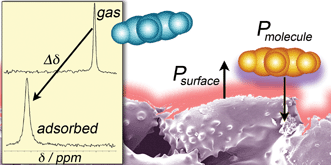19F Magic angle spinning NMR reporter molecules: empirical measures of surface shielding, polarisability and H-bonding†
Abstract
Magic Angle Spinning (MAS) 19F NMR spectra have been obtained and chemical shifts measured for 37 molecules in the gas phase and adsorbed on the surfaces of six common materials: octadecyl- and octyl-functionalised chromatography silicas, Kieselgel 100 silica, Brockmann neutral alumina, Norit activated charcoal and 3-(1-piperidino)propyl functionalised silica. From these six surfaces, octadecyl-silica is selected as a non-polar reference to which the others are compared. The change in chemical shift of a fluorine nucleus within a molecule on adsorption to a surface from the gas phase, Δδsurfacegas, is described by the empirical relationship:  , where δs and δr are constants that describe the chemical shift induced by the electromagnetic field of the surface under investigation and reference surface, αs and αr are the relative surface polarisability for the surface and reference, πs is an additional contribution to the surface polarisabilities due to its ability to interact with aromatic molecules, and δHBA and δHBD are measurements of the hydrogen acceptor and donor properties of the surface. These empirical parameters are measured for the surfaces under study. Silica and alumina are found to undergo specific interactions with aromatic reporter molecules and both accept and donate H-bonds. Activated charcoal was found to have an extreme effect on shielding but no specific interactions with the adsorbed molecules. 3-(1-Piperidino)propyl functionalised silica exhibits H-bond acceptor ability, but does not donate H-bonds.
, where δs and δr are constants that describe the chemical shift induced by the electromagnetic field of the surface under investigation and reference surface, αs and αr are the relative surface polarisability for the surface and reference, πs is an additional contribution to the surface polarisabilities due to its ability to interact with aromatic molecules, and δHBA and δHBD are measurements of the hydrogen acceptor and donor properties of the surface. These empirical parameters are measured for the surfaces under study. Silica and alumina are found to undergo specific interactions with aromatic reporter molecules and both accept and donate H-bonds. Activated charcoal was found to have an extreme effect on shielding but no specific interactions with the adsorbed molecules. 3-(1-Piperidino)propyl functionalised silica exhibits H-bond acceptor ability, but does not donate H-bonds.


 Please wait while we load your content...
Please wait while we load your content...